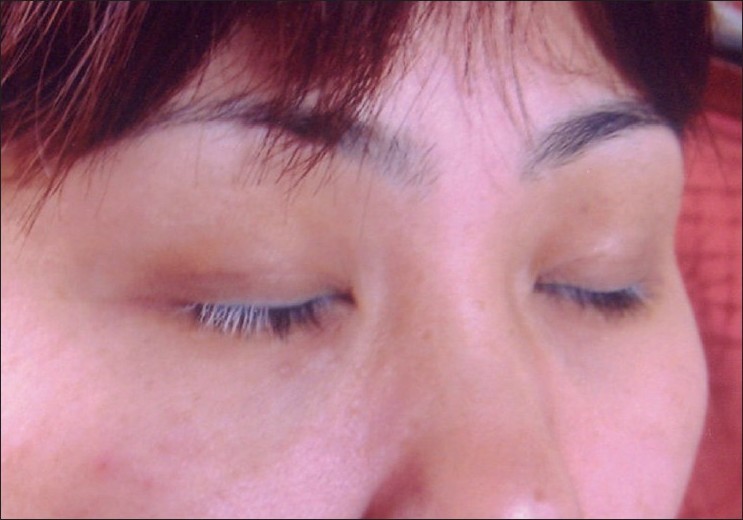Translate this page into:
Permanent leukotrichia after Q-switched 1064 nm laser tattoo removal
Correspondence Address:
Meng-Hua Huo
No. 33, Road Badachu, Beijing - 100 144
China
| How to cite this article: Liu XJ, Huo MH. Permanent leukotrichia after Q-switched 1064 nm laser tattoo removal. Indian J Dermatol Venereol Leprol 2011;77:81-82 |
Sir,
For unwanted tattoo, traditional treatment is to remove the ink-containing skin by chemical peel, cryosurgery, surgical excision or CO 2 laser treatment. However, these methods can induce permanent scarring. Anderson and Parrish′s principle of selective photothermolysis revolutionized the removal of tattoos. [1] In general, Q-switched laser can effectively remove unwanted tattoo without complications. As we know, the laser irradiation can bleach the hair shaft, and the hair will ultimately recover while the new hair shaft is regrowing. To our knowledge, there is no report that tattoo removal by Q-switched 1064 nm laser can result in permanent whitening of eyelashes.
A 36-year-old, skin type IV, Mongoloid female presented with black, wide and unsatisfactory tattoos in her upper and lower eyelid margin [Figure - 1]. There was no history of any depigmented skin lesions. To provide protection from laser treatment, intraocular patient eyeshield was applied after 2% lidocaine conjunctiva anesthesia, and laser goggles were worn by the physician. After the laser beam was ensured to aim at the treated area, the patient only received a single treatment with Q-switched Nd:YAG laser (Medlite C 3, HOYA ConBio, Freemont, CA, USA) at 1064 nm, with a 2-mm spot size and fluence of 2.0 J/cm 2 under local infiltration anesthesia (1% lidocaine with 1:100,000 epinephrine). There was immediate frost-like whitening of the treated area without immediate punctual bleeding or blistering, and the whitening lasted for several minutes. After the treatment, an anti-bacterial ointment was applied and a thin crust was developed within 48 hours, which lasted for 7 days. After desquamation of crust, the tattoo was significantly lightened without scarring. Unfortunately, the patient′s eyelashes, including upper and lower eyelids, remained white without any other discomfort for 5 years and there was no sign of repigmentation [Figure - 2].
 |
| Figure 1 :Clinical photograph showing black tattoo in eyelid margin |
 |
| Figure 2 :Clinical photograph showing whitening of eyelashes after 5 years of Q-switched 1064 nm laser tattoo removal |
Q-switched lasers have been extensively used to treat pigmented lesions and tattoos with excellent results. The mechanism of laser tattoo removal is based on the selective photothermolysis. The target of the lasers is tattoo inks. When the inks absorb laser energy within nanoseconds, they are broken up into tiny fragments, which are removed through the body′s natural cleansing mechanism. For its longer wavelength, higher fluence, and shorter pulse duration, the Q-switched 1064 nm laser is more effective in removing black ink without hypopigmentation.
Permanent leukotrichia by Q-switch 532 and 1064 nm laser was reported only in guinea pig skin, [2] not in human laser tattoo removal. However, the complications of the long pulse (not Q-switched) laser [3] or intense pulsed light hair removal were reported. [4],[5] Although the real reason of leukotrichia is still unknown, it is presumed that while ink particles are destroyed by laser, melanocytes are simultaneously damaged because the configuration of ink particles is similar to that of melanin within the hair follicles; the ink particles are in close contact with the melanocytes; and the heat produced by laser is enough to destroy or impair the function of melanocytes but insufficient to damage the germinative cell because the pulse duration of Q-switched laser is much shorter than the thermal relaxation time of chromophore (ink particles or melanin in melanocytes), and the heat produced by absorption of such chromophore is restricted within itself, and has not enough time to transfer to and damage the germinative cells, which results in growth of pigmentless eyelashes.
The leukotrichia can be concealed by applying mascara or removed by electrolysis.
| 1. |
Anderson RR, Parrish JA. Selective photothermolysis: Precise microsurgery by selective absorption of pulsed radiation. Science 1983;220:524-7.
[Google Scholar]
|
| 2. |
Anderson RR, Margolis RJ, Watenabe S, Flotte T, Hruza GJ, Dover JS. Selective photothermolysis of cutaneous pigmentation by Q-switched Nd: YAG laser pulses at 1064, 532, and 355 nm. J Invest Dermatol 1989;93:28-32.
[Google Scholar]
|
| 3. |
Hιlou J, Soutou B, Jamous R, Tomb R. Novel adverse effects of laser-assisted axillary hair removal. Ann Dermatol Venereol 2009;136:495-500.
[Google Scholar]
|
| 4. |
Radmanesh M, Azar-Beig M, Abtahian A, Naderi AH. Burning, paradoxical hypertrichosis, leukotrichia and folliculitis are four major complications of intense pulsed light hair removal therapy. J Dermatolog Treat 2008;19:360-3.
[Google Scholar]
|
| 5. |
Radmanesh M, Mostaghimi M, Yousefi I, Mousavi ZB, Rasai S, Esmaili HR, et al. Leukotrichia developed following application of intense pulsed light for hair removal. Dermatol Surg 2002;28:572-4.
[Google Scholar]
|
Fulltext Views
3,933
PDF downloads
3,190





